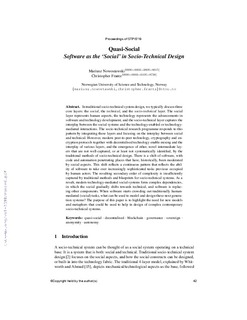| dc.description.abstract | In traditional socio-technical system design, we typically discuss three core layers: the social, the technical, and the socio-technical layer. The social layer represents human aspects, the technology represents the advancements in software and technology development, and the socio-technical layer captures the interplay between the social systems and the technology-enabled or technologymediated interactions. The socio-technical research programme responds to this pattern by integrating these layers and focusing on the interplay between social and technical. However, modern peer-to-peer technology, cryptography and encryption protocols together with decentralised technology enable mixing and the interplay of various layers, and the emergence of other, novel intermediate layers that are not well-captured, or at least not systematically identified, by the traditional methods of socio-technical design. There is a shift of software, with code and automation penetrating places that have, historically, been moderated by social aspects. This shift reflects a continuous pattern that reflects the ability of software to take over increasingly sophisticated tasks previous occupied by human actors. The resulting secondary order of complexity is insufficiently captured by traditional methods and blueprints for socio-technical systems. As a result, modern technology-mediated social systems form complex dependencies, in which the social gradually shifts towards technical, and software is replacing other components. When software starts crowding out traditionally humanmediated (social) tasks, what can be used to model and design these next generation systems? The purpose of this paper is to highlight the need for new models and metaphors that could be used to help in design of complex contemporary socio-technical systems. | nb_NO |
